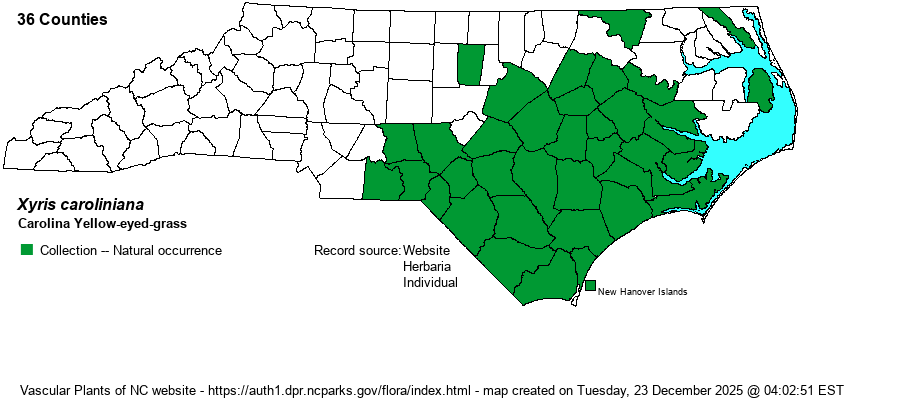| Author | Walter | |
| Distribution | Coastal Plain and Sandhills. Local on barrier islands (Carolina Beach SP), and surprisingly scarce in the northern Coastal Plain. Also known from several sites in the lower Piedmont.
Coastal Plain, southeastern VA to southern FL and eastern TX; southern NJ; Cuba. | |
| Abundance | Frequent to often common, except in the northern portion of the province and on coastal islands. The species is one of our most numerous Xyris species, and the State Rank probably should be moved from the NCNHP's S4 to S5. | |
| Habitat | Moist to seasonally moist, even dry, Longleaf Pine-Wiregrass savannas, flatwoods, sandhills, and slopes. This is the most dry-tolerant of our yellow-eyed-grasses, often quite far from any permanent soil moisture. |
| Phenology | Flowering and fruiting June-September. | |
| Identification | Carolina Yellow-eyed-grass is readily identified by its less-wet habitat, twisted stems, twisted leaves, and relatively narrow heads that taper to both ends. The rather expanded, corm-like base has led some collectors to identify plants as Slender Yellow-eyed-grass (X. torta), which see; that species is essentially found just in the Piedmont and mountains, with very little geographic overlap in NC. | |
| Taxonomic Comments | Members of Xyris are easy to identify to genus, but can be a challenge to identify species. Careful observation of a few features with a hand-lens is usually sufficient. Close attention must be paid to the flowering head, which is composed of overlapping brown scales. Immediately behind each scale are two brown "lateral sepals"; the margins of these may be feathery or irregularly lacerate (cut into narrow segments) or finely cut into short, comb-like prickles. Lateral sepals may be hidden or a bit longer than each scale. The flowers themselves are usually of little diagnostic value, other than time of flowering -- morning vs. afternoon. Seed size and ornamentation can also be useful characters, but require a dissecting scope to see well. Note also whether leaves and scapes (stems) are twisted and the color of the basal portion. All species have 2-ranked leaves, but in some species the leaves are arranged in a broad, fan-like shape. Finally, note the leaf and stem surface texture -- whether smooth of with little pale bumps. See Godfrey & Wooten (1979) for detailed descriptions and drawings. | |
| Other Common Name(s) | Pineland Yellow-eyed-grass (the preferred name for X. stricta) | |
| State Rank | S4 [S5] | |
| Global Rank | G4G5 [G5] | |
| State Status | | |
| US Status | | |
| USACE-agcp | FACW link |
| USACE-emp | FACW link |

